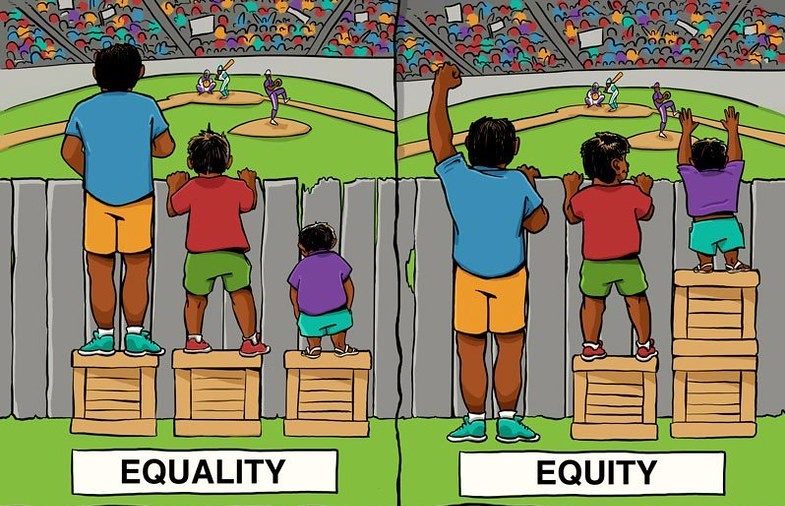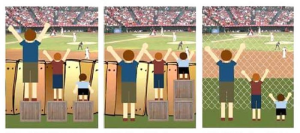13 Diversity, Equity and Inclusion
Chapter Objectives
After this chapter, you should be able to:
- Define diversity, equity, and inclusion.
- Examine the importance of diversity.
- Distinguish the difference between equity and equality.
- Explain what inclusion means.
- Discuss some ways programs should be inclusive.
Diversity
Let’s begin by defining diversity and exploring its significance to working with children. The concept of diversity means understanding that each individual is unique, and recognizing our individual differences. These can be along the dimensions of race, ethnicity, gender, sexual orientation, socio-economic status, age, physical abilities, religious beliefs, political beliefs, or other ideologies. It is the exploration of these differences in a safe, positive, and nurturing environment. It is about understanding each other and moving beyond simple tolerance to embracing and celebrating the rich dimensions of diversity contained within each individual.

Diversity is a reality created by individuals and groups from a broad spectrum of demographic and philosophical differences. It is extremely important to support and protect diversity, to value individuals and groups without prejudice, and foster a climate where equity and mutual respect are intrinsic.
Diversity means more than just acknowledging and/or tolerating difference. Diversity is a set of conscious practices that involve:[1]
- Understanding and appreciating interdependence of humanity, cultures, and the natural environment.
- Practicing mutual respect for qualities and experiences that are different from our own.
- Understanding that diversity includes not only ways of being but also ways of knowing;
- Recognizing that personal, cultural and institutionalized discrimination creates and sustains privileges for some while creating and sustaining disadvantages for others;
- Building alliances across differences so that we can work together to eradicate all forms of discrimination.
Diversity includes, therefore, knowing how to relate to those qualities and conditions that are different from our own and outside the groups to which we belong, yet are present in other individuals and groups. These include but are not limited to age, ethnicity, class, gender, physical abilities/qualities, race, sexual orientation, as well as religious status, gender expression, educational background, geographical location, income, marital status, parental status, and work experiences. Finally, we acknowledge that categories of difference are not always fixed but also can be fluid, we respect individual rights to self-identification, and we recognize that no one culture is intrinsically superior to another”.[2]
Equity
In education, the term equity refers to the principle of fairness. While it is often used interchangeably with the related principle of equality, equity encompasses a wide variety of educational models, programs, and strategies that may be considered fair, but not necessarily equal.[3] In other words, equity means making sure every student has the support they need to be successful.
Equity in education “requires putting systems in place to ensure that every child has an equal chance for success. That requires understanding the unique challenges and barriers faced by individual students or by populations of students and providing additional supports to help them overcome those barriers. While this in itself may not ensure equal outcomes, we all should strive to ensure that every child has equal opportunity for success.”[4] Unlike equity, equality ignores the fact that different people begin with different resources and barriers, and therefore will need more or less support as a result.[5]
Following image a simplified visual of difference between equality (giving everyone the same thing) and equity (giving each person what they need).

Other images have been created show that equity isn’t quite that simple and often what is creating the inequity is not characteristics of the person (such as height as shown in the image), but in the system. Systemic oppression and unearned privilege are addressed in later chapters of this book.

Why Does Educational Equity Matter?
When we think of a fair and just society one of the defining characteristics is likely to be that all individuals have equal opportunity to realize their potential, irrespective of the circumstances into which they are born. Education plays a critical role in determining whether or not individuals are given this opportunity. There are a range of reasons why good educational outcomes matter, from the individual; better health and longer life, to the societal; greater social cohesion, inclusion and trust; to the economic, productivity, economic growth, innovation, social wealth and reduced welfare costs. For a society or nation committed to ‘creating a fair and egalitarian place in which opportunities exist for all’, education is a key lever or vehicle through which this can occur.[6]

Inclusion
When we talk about inclusive early childhood education, we are talking about programs that are designed for children and families from a wide range of backgrounds. A program can serve diverse families, but not be truly inclusive; you can have families from different backgrounds in your program, but do they feel welcome? Are you forcing them to adapt to a program that isn’t designed for them or that doesn’t take into consideration their social, cultural, and/or racial contexts? Designing an inclusive program translates to everything from physical space to how you interact with children and families.[7]
Inclusion and Children with Disabilities
Inclusion embodies the values, policies, and practices that support the right of every child and their family, regardless of ability, to participate in a broad range of activities and contexts as full members of families, communities, and society. The desired results of inclusive experiences for children with and without disabilities and their families include a sense of belonging and membership, positive social relationships and friendships, and development and learning to reach their full potential. The defining features of inclusion that can be used to identify high quality early childhood programs and services are:
- Access – providing access to a wide range of learning opportunities, activities, settings, and environments.
- Participation – even if environments and programs are designed to facilitate access, some children will need additional individualized accommodations and supports to participate fully in play and learning activities with peers and adults.
- Supports – an infrastructure of systems-level supports must be afforded to those providing inclusive services to children and families.[8]

Children with disabilities and their families continue to face significant barriers to accessing inclusive high-quality early childhood programs and too many preschool children with disabilities are only offered the option of receiving special education services in settings separate from their peers without disabilities.[9]
Review Question
- Describe your understanding of how diversity, equity, and inclusion are related.
Summary
Early childhood programs serve a diverse array of children and families. Recognizing the value of this diversity and creating relationships with families that provide the context of their culture, will allow early childhood education programs to be inclusive in a variety of different ways and provide educational equity for the children for whom they provide care and education.
Image Credits
Blackall, L. (2016, November 2). Equality/Equityis. Flickr. CC BY 2.0. https://flic.kr/p/NPgGni
California Department of Education. (n.d.). Images from A Guide to Culturally Sensitive Care, used with permission.
City for All Women Initiative [CAWI]. (2015). Advancing Equity and Inclusion: A Guide for Municipalities. https://www.cawi-ivtf.org/wp-content/uploads/advancing-equity-inclusion-en.pdf
Chapter Attribution
Adapted from Unit 1.1 Diversity by Krischa Esquivel, Emily Elam, Jennifer Paris, & Maricela Tafoya in The Role of Equity and Diversity in Early Childhood Education published in LibreText by College of the Canyons under a CC BY license.
- Queensborough Community College. (2021). Definition for Diversity. https://www.qcc.cuny.edu/diversity/definition.htm ↵
- Ibid ↵
- The Glossary of Education Reform by the Great Schools Partnership is licensed under CC BY-NC-SA 4.0 ↵
- Thought Leaders. (2018). Equity in Education: What it Is and Why it matters. https://www.thinkingmaps.com/equity-education-matters/ ↵
- Diversity, Equity, and Inclusion by Bethany Theme is licensed under CC BY 4.0 ↵
- The Future of Education by ACT Government Education is licensed under Creative Commons Attribution 4.0 International unless otherwise stated. ↵
- Diversity, Equity, and Inclusion by Bethany Theme is licensed under CC BY 4.0 ↵
- Early Childhood Inclusion by DEC/NAEYC—Permission to copy not required—distribution encouraged (page 2) ↵
- Policy Statement on Inclusion of Children with Disabilities in Early Childhood Programs by the US Department of Health and Human Services & the US Department of Education is in the public domain (page 2) ↵

